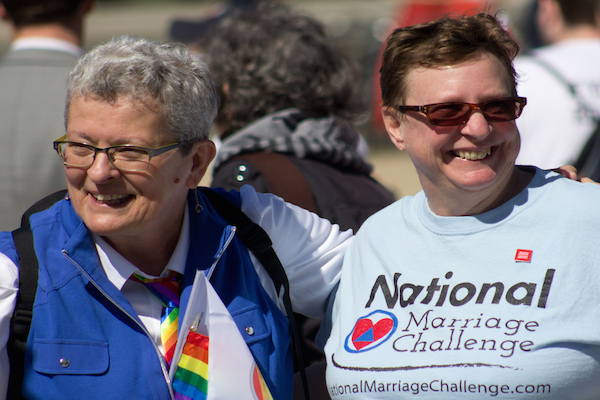The nation has been waiting with bated breath to hear the ruling in Obergefell vs Hodges since that historical day April 28 when the Supreme Court heard arguments on marriage equality. Hundreds of supporters stood outside the courthouse, while inside the verbal sparring came to head.
Today, the Supreme Court declared that same-sex couples have a right to marry anywhere in the United States. The court’s 5-4 ruling means the remaining 14 states, in the South and Midwest, will have to stop enforcing their bans on same-sex marriage.
The courts ruled: “Held: The Fourteenth Amendment requires a State to license a marriage between two people of the same sex and to recognize a marriage between two people of the same sex when their marriage was lawfully licensed and performed out-of-State”. Also stating: “The right to marry is a fundamental right inherent in the liberty of the person, and under the Due Process and Equal Protection Clauses of the Fourteenth Amendment couples of the same-sex may not be deprived of that right and that liberty. Same-sex couples may exercise the fundamental right to marry. The State laws challenged by the petitioners in these cases are held invalid to the extent they exclude same-sex couples from civil marriage on the same terms and conditions as opposite-sex couples”.
 This is the first time the Supreme Court has decided to hear cases on same-sex marriage. The driving force behind this decision was the November ruling from the Sixth Circuit to uphold the ban on same-sex marriage in the case of Obergefell vs Himes. Jim Obergefell married 20 year partner John Arthur in 2013, but when John passed away 3 months and 11 days later from ALS, Obergefell wanted the right to be listed as the surviving spouse on Arthur’s death certificate. The Sixth Circuit court asserted the ban on same-sex marriage did not violate the constitution. This caused a rift in the circuit courts since the previously unanimous trend had been of federal courts striking down the ban. As such a circuit split was created; leaving the Supreme Court with no choice but to intervene.
This is the first time the Supreme Court has decided to hear cases on same-sex marriage. The driving force behind this decision was the November ruling from the Sixth Circuit to uphold the ban on same-sex marriage in the case of Obergefell vs Himes. Jim Obergefell married 20 year partner John Arthur in 2013, but when John passed away 3 months and 11 days later from ALS, Obergefell wanted the right to be listed as the surviving spouse on Arthur’s death certificate. The Sixth Circuit court asserted the ban on same-sex marriage did not violate the constitution. This caused a rift in the circuit courts since the previously unanimous trend had been of federal courts striking down the ban. As such a circuit split was created; leaving the Supreme Court with no choice but to intervene.
Now his case has been combined with three others: Tanco v. Haslam (Tennessee), DeBoer v. Snyder (Michigan), and Bourke v. Beshear (Kentucky) in the current Obergefell vs Hodges case brought before the Supreme Court. The current case answered two main questions. Does the Fourteenth Amendment compel a state to license a marriage between two people of the same sex? Does the Fourteenth Amendment require a state to recognize a marriage between two people of the same sex when their marriage was lawfully licensed and performed out-of-state? The Fourteenth Amendment very broadly forbids states from denying any person life, liberty or property, without due process of law or to deny to any person within its jurisdiction the equal protection of the laws.
During the April 28 hearing, a fierce fight was raised on both sides. They discussed how to define marriage. They disputed whether or not marriage is wrapped around procreating or if it should be about the bond of two people that love each other. They argued that marriage is embedded in our constitutional right and protected under the 14th amendment.
When the arguments were done on April 28 Chief Justices Elena Kagan, Sonia Sotomayor, Ruth Bader Ginsburg and Stephen Breyer were all expected to rule in favor of same sex-marriage. Samuel Alito, Clarence Thomas and Antonin Scalia were expected to be in favor of the ban on same sex-marriage. Chief Justice John Roberts and Anthony Kennedy were thought to be the swing votes.
Now that they have voted in favor of same-sex marriage the Supreme Court will have to lay out expectations for states to allow same sex unions. Previously, states that banned same sex marriage did not have to recognize unions of two people of the same-sex when their marriage was performed out of state. Under the new laws, those marriages will be protected not only in the state the marriage was performed, but also in the state that the couples now reside. All same-sex couples in every state will have legal rights and benefits under the new ruling but it is possible that state legislatures may try to pass bills to circumvent the court’s decisions.
“Today, I think back to 2008, when I was finally able to marry the woman I have shared my life with for nearly 25 years. It was an incredibly joyous day and so important to us and our daughter. My heart is so full knowing all loving couples across our great nation will now be able to share in the freedom to marry. Our community owes much gratitude to the legal groups, plaintiffs, state-based organizations, and, especially, to all the couples and families who bravely shared their stories for the past several decades. I’ve never felt more energized to get the work done so that all Americans can be fully equal and protected under the law,” said Equality Federation Executive Director Rebecca Isaacs.
Watch the video from the National Center for Lesbian Rights who played an intricate role in the fight for marriage equality.

